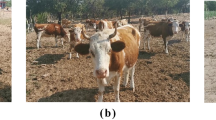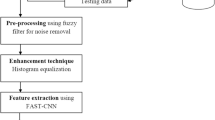Abstract
In this study we have developed and experimented with two methods of teat detection based on machine learning approach in image recognition and object detection. Automatic milking systems rely strongly on the vision system for successful milking operation initiation which is the attachment of the teat cups correctly. Teat detection method currently employed in the industry is based on laser assisted edge detection mechanism, making the current systems less advanced than the existing methods in the field of image processing and robotic vision. By experimenting on a basic object detection method based on Haar-like features, viz. Haar cascade classification method and a latest state-of-the-art method based on convolutional neural nets, viz. YOLO-object detection method, we have compared the results of detection on a fake teat model casted from silicon, especially for indoor environments. This study is in extension to the successful real time detection in a cow farm using Haar-cascade based algorithm.
Similar content being viewed by others
References
F. Marinello, A. Pezzuolo, F. Gasparini, J. Arvidsson and L. Sartori, Application of Kinect sensor for dynamic soil surface characterization, Precision Agriculture, 5 (2015) 1–12.
K. De Koning, Y. van der Vost and A. Meijering, Automatic Milking Experience and Development in Europe, Wageningen Academic Publishers, Wageningen, the Netherlands (2002) 1–11.
H. Hofman, C. Rujiter, M. Koekoek and P. Williem ver der Sluis, milking box with robotic attacher and vision system, US 2012/0272914 A1, USA (2012).
DeLaval. AMR System Overview, Accessed on: 12th Sept. 2015, https://doi.org/www.delaval.co.uk/About-DeLaval/Innovation-at-DeLaval/AMR-System-Overview/.
M. A. Akhloufi, 3D vision system for intelligent milking robot automation, SPIE, Proceedings of the International Society for Optical Engineering, December (2013).
Gartner’s Inc Gartner Hype Cycle for Emerging Technologies, Gartner’s Inc Connecticut (2016).
Gil Press, 5 Top Technologies for Digital Disruption.
Martinus Petrus Kortekaas, Milking Robot for Attaching a Teat Cup, August (2015).
P. I. Wilson and J. Fernandez, Facial feature detection using Haar classifiers, Journal of Computing Science in Colleges, 21(4) April (2006) 127–133.
P. Viola and M. Jones, Rapid object detection using boosted cascade of simple features, IEEE Conference on Computer Vision and Pattern Recognition (2001).
Y. Freund and R. E. Schapire, A decision-theoretic generalization of on-line learning and an application to boosting, Journal of Computer and System Science, 55(1) (1997) 119–139.
M. Rezaei, Creating a Cascade of Haar Like Classifiers Step by Step (2014) [online] Available: https://doi.org/www.cs.auckland.ac.nzlo.-m.rezaei/Tutorials/Creating_a_Cascade_of_Haar-Like_Classifiers_Step_by_Step.pdf.
A. Rastogi, A. Pal and B. S. Ryuh, Real-time teat detection using haar cascade classifier in smart automatic milking system, 2017 7th IEEE International Conference on Control System, Computing and Engineering (ICCSCE), Penang (2017) 74–79.
J. Redmon, S. Divvala, R. Girshick and A. Farhadi, You Only Look Once: Unified, Real-time Object Detection, arXiv preprint arXiv:1506.02640 (2015).
J. Redmon and A. Farhadi, Yolo9000: Better, Faster, Stronger, arXiv preprint arXiv:1612.08242 (2016).
T. H. Trieu, Darkflow, Accessed on: 11th Oct. (2016) https://doi.org/github.com/thtrieu/darkflow.
M. Jay, YOLO Series, Accessed on: 11th Oct. (2016) https://doi.org/github.com/markjay4k/YOLO-series.
Author information
Authors and Affiliations
Corresponding author
Additional information
Recommended by Associate Editor Joonbum Bae
Akanksha Rastogi received her Bachelor of Architecture degree from National Institute of Technology, Hamipur, India in 2013 and MBA in Real Estate and Urban Infra. Mgmt. from RICS School of Built Environment, Noida, India in 2016. She is currently pursuing M.S. in Mechanical System Engineering at Chonbuk National University, Jeonju, Korea.
Beom-Sahng Ryuh received his bachelor’s and master’s degrees at Seoul National University, Korea in 1979 and 1981, respectively. He received his Ph.D. at Purdue University, U.S.A. in 1989. Dr. Ryuh is currently a Professor of School of Mechanical System Engineering at Chonbuk National University, Jeonju, Korea.
Rights and permissions
About this article
Cite this article
Rastogi, A., Ryuh, B.S. Teat detection algorithm: YOLO vs. Haar-cascade. J Mech Sci Technol 33, 1869–1874 (2019). https://doi.org/10.1007/s12206-019-0339-5
Received:
Revised:
Accepted:
Published:
Issue Date:
DOI: https://doi.org/10.1007/s12206-019-0339-5




